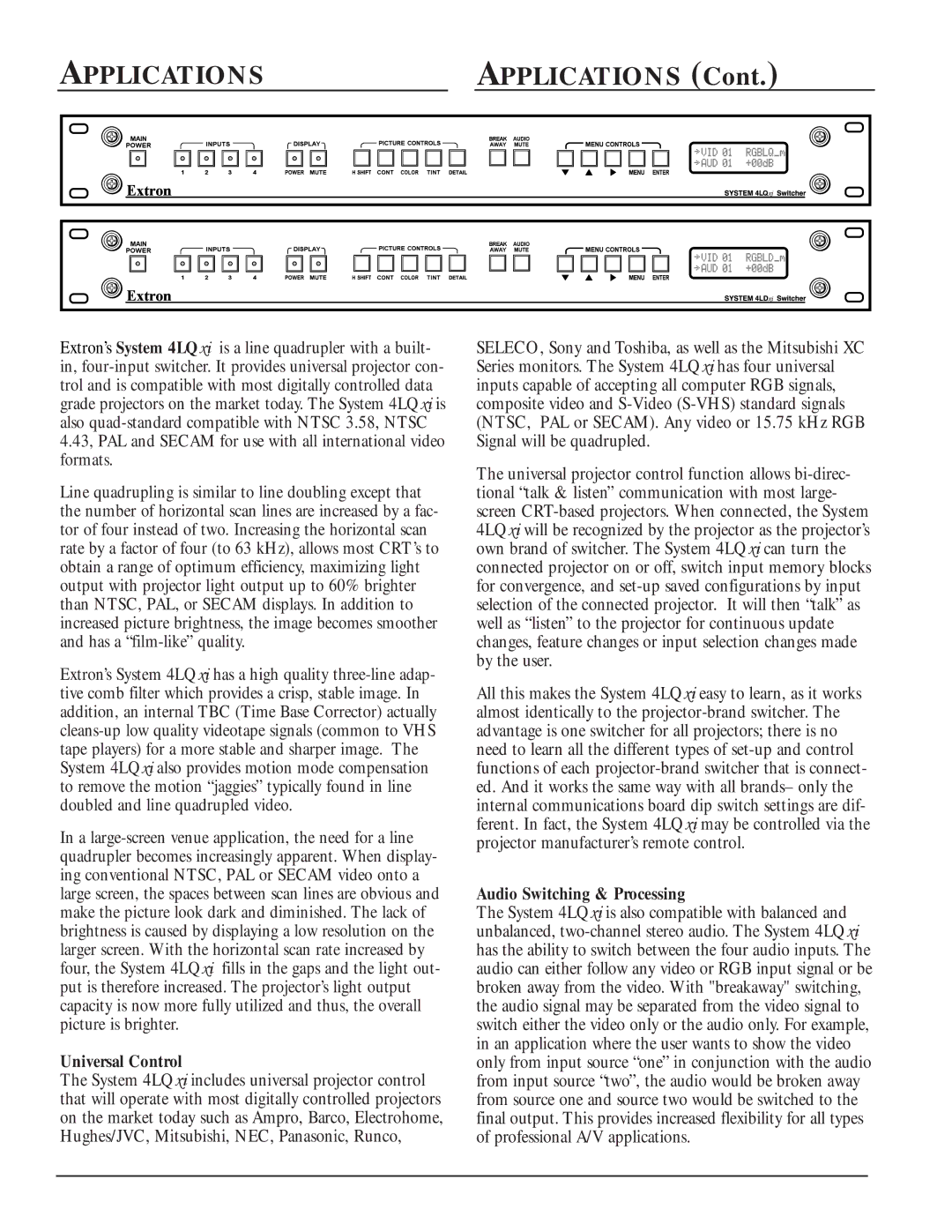Extron’s System 4LQxi is a line quadrupler with a built- in, four-input switcher. It provides universal projector con- trol and is compatible with most digitally controlled data grade projectors on the market today. The System 4LQxi is also quad-standard compatible with NTSC 3.58, NTSC 4.43, PAL and SECAM for use with all international video formats.
Line quadrupling is similar to line doubling except that the number of horizontal scan lines are increased by a fac- tor of four instead of two. Increasing the horizontal scan rate by a factor of four (to 63 kHz), allows most CRT’s to obtain a range of optimum efficiency, maximizing light output with projector light output up to 60% brighter than NTSC, PAL, or SECAM displays. In addition to increased picture brightness, the image becomes smoother and has a “film-like” quality.
Extron’s System 4LQxi has a high quality three-line adap- tive comb filter which provides a crisp, stable image. In addition, an internal TBC (Time Base Corrector) actually cleans-up low quality videotape signals (common to VHS tape players) for a more stable and sharper image. The System 4LQxi also provides motion mode compensation to remove the motion “jaggies” typically found in line doubled and line quadrupled video.
In a large-screen venue application, the need for a line quadrupler becomes increasingly apparent. When display- ing conventional NTSC, PAL or SECAM video onto a large screen, the spaces between scan lines are obvious and make the picture look dark and diminished. The lack of brightness is caused by displaying a low resolution on the larger screen. With the horizontal scan rate increased by four, the System 4LQxi fills in the gaps and the light out- put is therefore increased. The projector’s light output capacity is now more fully utilized and thus, the overall picture is brighter.
Universal Control
The System 4LQxi includes universal projector control that will operate with most digitally controlled projectors on the market today such as Ampro, Barco, Electrohome, Hughes/JVC, Mitsubishi, NEC, Panasonic, Runco,
SELECO, Sony and Toshiba, as well as the Mitsubishi XC Series monitors. The System 4LQxi has four universal inputs capable of accepting all computer RGB signals, composite video and S-Video (S-VHS) standard signals (NTSC, PAL or SECAM). Any video or 15.75 kHz RGB Signal will be quadrupled.
The universal projector control function allows bi-direc- tional “talk & listen” communication with most large- screen CRT-based projectors. When connected, the System 4LQxi will be recognized by the projector as the projector’s own brand of switcher. The System 4LQxi can turn the connected projector on or off, switch input memory blocks for convergence, and set-up saved configurations by input selection of the connected projector. It will then “talk” as well as “listen” to the projector for continuous update changes, feature changes or input selection changes made by the user.
All this makes the System 4LQxi easy to learn, as it works almost identically to the projector-brand switcher. The advantage is one switcher for all projectors; there is no need to learn all the different types of set-up and control functions of each projector-brand switcher that is connect- ed. And it works the same way with all brands– only the internal communications board dip switch settings are dif- ferent. In fact, the System 4LQxi may be controlled via the projector manufacturer’s remote control.
Audio Switching & Processing
The System 4LQxi is also compatible with balanced and unbalanced, two-channel stereo audio. The System 4LQxi has the ability to switch between the four audio inputs. The audio can either follow any video or RGB input signal or be broken away from the video. With "breakaway" switching, the audio signal may be separated from the video signal to switch either the video only or the audio only. For example, in an application where the user wants to show the video only from input source “one” in conjunction with the audio from input source “two”, the audio would be broken away from source one and source two would be switched to the final output. This provides increased flexibility for all types of professional A/V applications.

